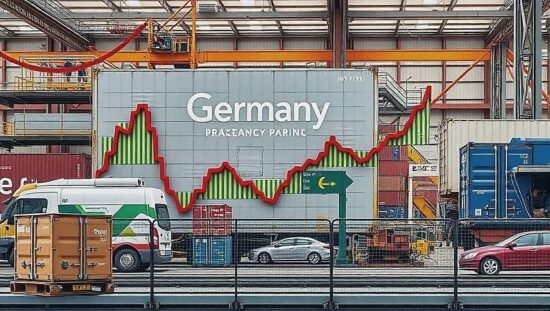Economic Forecasts Revising Upward for Germany and the Eurozone
The Leibniz Institute for Economic Research in Halle (IWH) has revised its economic forecast for Germany and the eurozone, projecting a moderate upswing in production for the coming years. According to the institute, the German economy is expected to experience a 0.4% increase in production in 2025, the first growth since 2023, provided that the US does not escalate its trade conflicts further.
The IWH’s initial forecast in March had predicted a 0.1% growth for the current year, with a 1.1% growth expected for 2026. Similar expansion rates are also anticipated for the eastern region of Germany.
The institute attributes the improvement in the economic outlook to a temporary boost in demand from the US, driven by the expectation of higher tariffs. This led to a surge in US imports in the first quarter of 2025, giving the eurozone economy a small boost. The price dynamics in the US and the eurozone have continued to ease, partly due to a significant decline in the oil price.
The IWH expects interest rates to be lowered further in both the US and the eurozone in the course of the year. However, the US’s fiscal policy is expected to negatively impact the economy in both 2025 and 2026. In contrast, the fiscal policy in the eurozone is expected to be neutral.
World trade is likely to decline significantly in the second half of 2025 due to the US tariffs, but the IWH’s forecast assumes that the trade conflicts will not escalate further, thus avoiding a recession. Overall, the world economy is expected to grow by 2.3% in both 2025 and 2026.
Oliver Holtemöller, the head of the IWH’s macroeconomic department, noted that the German economy is showing more and more signs of recovery, with business sentiment improving since the start of the year and production expanding by 0.4% in the first quarter of 2025. While exports did increase by 3.2% in the first quarter, this was partly due to the temporary boost in demand from the US. Private consumption also grew for the first time in a while, but private investment in equipment continued to decline, a trend that has been ongoing since 2023.
Structural problems, such as demographics, the energy transition and the structural changes in China, continue to weigh on the German economy. The ECB’s monetary policy, which has led to more favorable financing conditions for the real estate sector, is supporting the economy.
The IWH’s forecast assumes that US tariffs will remain at their current level. Under this assumption, the German export sector is likely to be negatively impacted in the second and third quarters, but the economic upswing is expected to be dampened but not derailed. The fiscal policy shift is not expected to have a significant impact on the economy until 2026, when the government’s budget deficit will remain high.
Holtemöller emphasized that a significant risk to the German economy lies in the potential escalation of US trade conflicts. The recent reduction of US tariffs on EU goods, announced in April, was only a temporary measure to allow for the negotiation of a deal. The ongoing conflict between the US and China also poses significant risks to the German economy, as it has led to a shortage of rare earths, which is affecting production in the manufacturing sector. The IWH’s economist noted that the economic rivalry between the US and China is putting a special strain on German industry, as it is deeply connected to producers in both economies.





